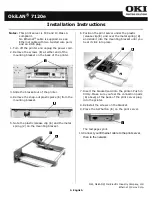
Technical Manual
U-SYS MRS6100 Media Resource Server
Chapter 7 Operation and Maintenance
Huawei Technologies Proprietary
7-9
7.4.4 Alarm Levels
Alarm levels are used to identify the severity of alarms. According to the severity,
the alarms are classified into the following four different levels.
z
Critical alarm: refers to the system-featured alarms on faults and events that
make the system down, such as the faults on SMUI and HSCI boards.
z
Major alarm: refers to the alarms on faults and events, which affect the
board/line in certain area, such as interface board fault and communication link
fault.
z
Minor alarm: refers to the alarms on ordinary faults and events that describe
the working state of boards or lines, such as board reset and PCM alarm.
z
Warning alarm: refers to the warnings that do not affect system performance,
such as switchover alarm.
7.4.5 Alarm Types
The alarms exported by the alarm console contain alarm types indicating the alarm
property. There are three types of alarms in the system: fault alarm, recovery alarm
and event alarm.
z
Fault alarm: refers to the alarm generated due to hardware equipment fault or
abnormity in some important functions.
z
Recovery alarm: refers to the alarm generated when the faulty equipment or
abnormal function recovers to normal. It is in one-to-one correspondence to
the fault alarm.
z
Event alarm: refers to the prompts or fault alarms that do not have
corresponding recovery alarms.
7.5 Traffic Statistics
Traffic statistics is also called traffic measurement, load measurement and
performance statistics, and refers to such activities as performing data
measurement, collection and statistics on MRS6100 devices (or communications
network). It is to observe and take statistics of the running status of MRS6100
devices and the usage of the signaling, users, and system resources, so as to
provide reliable data for device running management, fault location, network
monitoring and maintenance, and network planning and designing.
7.5.1 Traffic Statistics Type
Traffic statistics includes three basic elements: measurement index, measurement
object and measurement time.
















































